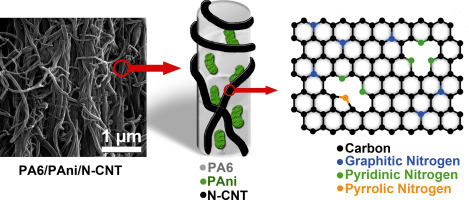当前位置:
X-MOL 学术
›
Mater. Des.
›
论文详情
Our official English website, www.x-mol.net, welcomes your
feedback! (Note: you will need to create a separate account there.)
Electrical conductivity of electrospun nanofiber mats of polyamide 6/polyaniline coated with nitrogen-doped carbon nanotubes
Materials & Design ( IF 7.6 ) Pub Date : 2018-03-01 , DOI: 10.1016/j.matdes.2017.12.052 João Paulo Ferreira Santos , Mohammad Arjmand , Guilherme Henrique França Melo , Kambiz Chizari , Rosario Elida Suman Bretas , Uttandaraman Sundararaj
Materials & Design ( IF 7.6 ) Pub Date : 2018-03-01 , DOI: 10.1016/j.matdes.2017.12.052 João Paulo Ferreira Santos , Mohammad Arjmand , Guilherme Henrique França Melo , Kambiz Chizari , Rosario Elida Suman Bretas , Uttandaraman Sundararaj

|
Abstract Conductive nanostructures have emerged as the next generation of functional materials for electronic devices. In this work, electrospun nanofiber mats of polyamide 6/polyaniline (PA6/PAni), with high porosity and high surface area, coated with nitrogen-doped carbon nanotubes (N-CNTs) were developed. Employing the chemical vapor deposition technique, N-CNTs were synthesized at various temperatures, e.g., 650, 750, 850, and 950 °C. PA6 and PA6/PAni nanofiber mats were produced employing the electrospinning technique. The mats were then dipped in an aqueous suspension containing dispersed and stabilized N-CNTs. The results revealed that the presence of PAni enhanced the adsorption of N-CNTs on the surface of nanofiber mats, thereby improving their electrical conductivity. The highest conductivity was obtained when the mats were coated with N-CNT650. However, the impact of PAni on the conductivity was higher when the mats were coated with N-CNTs synthesized at higher temperatures, i.e., 10− 12 S/cm for PA6/N-CNT950 and 10− 5 S/cm for PA6/PAni/N-CNT950, an increase of seven orders of magnitude. It was concluded that the physical features and nitrogen content of N-CNTs had a significant impact on the electrical behavior of the developed mats. Furthermore, it was realized that the synergistic effect between PAni and N-CNT can be employed to build nanostructures with improved conductivity.
中文翻译:

涂有氮掺杂碳纳米管的聚酰胺 6/聚苯胺电纺纳米纤维垫的导电性
摘要 导电纳米结构已成为下一代电子设备功能材料。在这项工作中,开发了具有高孔隙率和高表面积的聚酰胺 6/聚苯胺 (PA6/PAni) 电纺纳米纤维垫,并涂有掺氮碳纳米管 (N-CNT)。采用化学气相沉积技术,N-CNT 在各种温度下合成,例如 650、750、850 和 950 °C。PA6 和 PA6/PAni 纳米纤维垫采用静电纺丝技术生产。然后将垫浸入含有分散和稳定的 N-CNT 的水悬浮液中。结果表明,PAni的存在增强了N-CNTs在纳米纤维垫表面的吸附,从而提高了它们的导电性。当垫涂有 N-CNT650 时,电导率最高。然而,当垫子涂有在较高温度下合成的 N-CNTs 时,PAni 对电导率的影响更大,即 PA6/N-CNT950 为 10-12 S/cm,PA6/PAni 为 10-5 S/cm /N-CNT950,增加了七个数量级。得出的结论是,N-CNTs 的物理特性和氮含量对开发的垫子的电性能有显着影响。此外,人们意识到可以利用 PAni 和 N-CNT 之间的协同效应来构建具有改进导电性的纳米结构。增加了七个数量级。得出的结论是,N-CNTs 的物理特性和氮含量对开发的垫子的电性能有显着影响。此外,人们意识到可以利用 PAni 和 N-CNT 之间的协同效应来构建具有改进导电性的纳米结构。增加了七个数量级。得出的结论是,N-CNTs 的物理特性和氮含量对开发的垫子的电性能有显着影响。此外,人们意识到可以利用 PAni 和 N-CNT 之间的协同效应来构建具有改进导电性的纳米结构。
更新日期:2018-03-01
中文翻译:

涂有氮掺杂碳纳米管的聚酰胺 6/聚苯胺电纺纳米纤维垫的导电性
摘要 导电纳米结构已成为下一代电子设备功能材料。在这项工作中,开发了具有高孔隙率和高表面积的聚酰胺 6/聚苯胺 (PA6/PAni) 电纺纳米纤维垫,并涂有掺氮碳纳米管 (N-CNT)。采用化学气相沉积技术,N-CNT 在各种温度下合成,例如 650、750、850 和 950 °C。PA6 和 PA6/PAni 纳米纤维垫采用静电纺丝技术生产。然后将垫浸入含有分散和稳定的 N-CNT 的水悬浮液中。结果表明,PAni的存在增强了N-CNTs在纳米纤维垫表面的吸附,从而提高了它们的导电性。当垫涂有 N-CNT650 时,电导率最高。然而,当垫子涂有在较高温度下合成的 N-CNTs 时,PAni 对电导率的影响更大,即 PA6/N-CNT950 为 10-12 S/cm,PA6/PAni 为 10-5 S/cm /N-CNT950,增加了七个数量级。得出的结论是,N-CNTs 的物理特性和氮含量对开发的垫子的电性能有显着影响。此外,人们意识到可以利用 PAni 和 N-CNT 之间的协同效应来构建具有改进导电性的纳米结构。增加了七个数量级。得出的结论是,N-CNTs 的物理特性和氮含量对开发的垫子的电性能有显着影响。此外,人们意识到可以利用 PAni 和 N-CNT 之间的协同效应来构建具有改进导电性的纳米结构。增加了七个数量级。得出的结论是,N-CNTs 的物理特性和氮含量对开发的垫子的电性能有显着影响。此外,人们意识到可以利用 PAni 和 N-CNT 之间的协同效应来构建具有改进导电性的纳米结构。











































 京公网安备 11010802027423号
京公网安备 11010802027423号